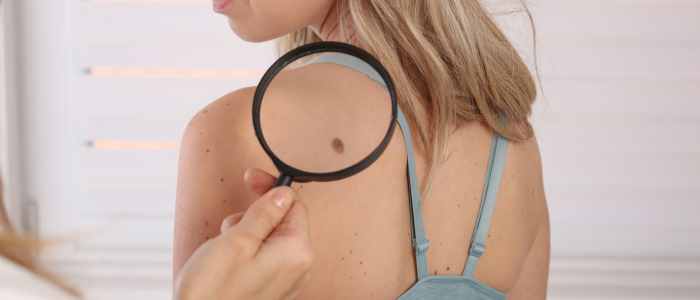
Table of Contents
- Guide to Recovery after Skin Tag Removal
- What to Expect Immediately After Removal
- Step-by-Step Recovery Guide after Skin Tag Removal
- Day 1-3: Immediate Care
- Week 1: Monitoring and Maintenance
- Week 2 and Beyond: Long-term Care
- Dos and Don’ts during Recovery after Skin Tag Removal
- Dos:
- Don’ts:
- FAQs about Recovery after Skin Tag Removal
- Further Reading about Skin Procedures with Chester Consultant Plastic Surgeon Anca Breahna
Guide to Recovery after Skin Tag Removal
Skin tag removal is a common procedure sought out by individuals looking to address both cosmetic concerns and physical discomfort. These benign growths, though harmless, can often be a source of self-consciousness or irritation, especially when located in areas prone to friction or visibility. The decision to remove skin tags, while relatively straightforward and minimally invasive, brings with it the anticipation of a recovery process.
When it comes to cosmetic procedures, the expertise and guidance of a skilled plastic surgeon cannot be overstated. Chester Consultant Plastic Surgeon Anca Breahna aims to shed light on the recovery process from the moment skin tags are removed, guiding you through each step with professional advice and insider tips. By following a meticulously planned aftercare regimen, you can minimise potential side effects and expedite the healing process, ensuring that the skin remains healthy post-procedure.
What to Expect Immediately After Removal
Upon undergoing skin tag removal, patients often enter a phase filled with anticipation about the results and the journey of healing that lies ahead. Immediately after the removal of a skin tag, it’s normal to experience minor bleeding, redness, or slight swelling around the treated area. These are typical responses of the skin to the procedure, whether the method involved was cryotherapy, cauterisation, ligation, or excision. The method of removal may influence the type and intensity of after-effects you experience. For instance, cryotherapy (freezing) might leave the area feeling numb or slightly irritated for a short period, while excision could result in a small wound that requires more detailed aftercare.
To manage any minor bleeding that occurs, Anca will apply a sterile bandage or dressing over the area immediately following the procedure. This not only helps in controlling the bleeding but also protects the site from infection. Patients are advised to keep the area clean and dry, changing the dressing according to the instructions provided by Anca. For the first 24 to 48 hours, it’s advisable to avoid activities that could stress the treated area, such as rigorous exercise or heavy lifting, which could exacerbate bleeding or swelling.
Redness and swelling are natural reactions of the body’s healing process. These symptoms can be effectively managed with cold compresses applied to the area for short durations within the first day. However, it’s important to ensure that the compress is not applied directly to the skin; instead, wrap it in a clean cloth to prevent any damage to the sensitive post-treatment skin.
Pain or discomfort following skin tag removal is minimal and can be managed with over-the-counter pain relief medication, following your plastic surgeon’s recommendations. It’s crucial to avoid any medication that can thin the blood, such as aspirin, unless specifically advised by Anca, as this can increase the risk of bleeding.
The treated area should be kept clean to prevent infection. Gently washing the area with mild soap and water and patting it dry carefully is usually recommended. In some cases, Anca may prescribe an antibiotic ointment to be applied to the area as part of the aftercare regimen, aiding in the prevention of infection and facilitating the healing process.
In the days immediately following skin tag removal, monitoring the site for signs of infection is paramount. While rare, signs to watch for include increased redness, swelling, warmth, pus, or a fever. Should any of these symptoms arise, it’s important to contact Anca’s team immediately for evaluation and possible treatment.
Step-by-Step Recovery Guide after Skin Tag Removal
Day 1-3: Immediate Care
In the first 72 hours post-skin tag removal, attention to care is important. The goal during this phase is to protect the wound, prevent infection, and minimise discomfort. Anca will have likely covered the area with a sterile dressing, which should be kept dry and intact for at least the first 24 hours, or as advised. If you were given a prescription for an antibiotic ointment, apply it as directed to the area after gently cleaning it with mild soap and water. This not only aids in keeping the site clean but also in keeping the area hydrated, which is crucial for healing.
During these initial days, it’s normal to notice some redness and swelling, which are signs of the body’s natural healing process kicking in. To alleviate swelling, apply a cold compress to the area for 10-15 minutes at a time, several times a day. Make sure to wrap the compress in a clean cloth to avoid direct contact with the skin. Pain is generally minimal but can be managed with over-the-counter pain relievers if necessary. Remember to consult with Anca on which pain relievers are safe to use, as some can increase the risk of bleeding.
Week 1: Monitoring and Maintenance
As you move into the first week, the focus shifts to monitoring the healing process and maintaining proper care of the area. By this time, any initial dressing can usually be removed, and you’ll be able to shower normally. It’s important to pat the area dry gently and avoid rubbing it. Continue to apply any prescribed ointments to promote healing and prevent infection.
This week, signs of infection should be vigilantly monitored. Any increasing redness, warmth, pus, or if you develop a fever, should prompt an immediate call to Anca’s office. These could be signs of an infection that requires medical intervention.
It’s also the time when you might begin to notice the formation of a scab over the treated area. It’s vital not to pick at the scab or attempt to remove it, as this is part of the natural healing process and helps protect the wound underneath.
Week 2 and Beyond: Long-term Care
By the second week, significant improvements in healing should be evident. The scab may start to loosen and eventually fall off on its own. Underneath, new, healthy skin will appear. Continue to protect this new skin from direct sunlight by applying a broad-spectrum sunscreen with at least SPF 30, as it will be more susceptible to sun damage and pigmentation changes.
At this stage, it’s also essential to start incorporating gentle skin care products that do not irritate the new skin. Products containing aloe vera or hyaluronic acid can help soothe and moisturise the area without causing irritation. Avoid any products with harsh chemicals, fragrances, or exfoliants that could disrupt the healing process.
Long-term care involves maintaining a healthy skincare routine and protecting the area from excessive sun exposure to prevent scarring and pigmentation issues. Regular check-ups with Anca can help ensure the site heals correctly and any concerns are addressed promptly.
Dos and Don’ts during Recovery after Skin Tag Removal
Dos:
- Do keep the area clean and dry: After the initial 24 hours, gently wash the area with mild soap and water and pat it dry carefully
- Do apply any prescribed medications: If Anca prescribed an antibiotic ointment or recommended over-the-counter products, use them as directed to prevent infection and aid in healing
- Do protect the area from the sun: Applying a broad-spectrum sunscreen to the area once it’s healed is crucial to prevent pigmentation changes
Don’ts:
- Don’t pick at scabs: Allow any scabs to fall off naturally to prevent scarring and infection
- Don’t use harsh skincare products: Avoid products with alcohol, fragrances, or exfoliants that can irritate the healing skin
- Don’t ignore signs of infection: Increased redness, swelling, warmth, pus, or a fever are signs that you should contact your surgeon immediately
Following these dos and don’ts can significantly influence the speed and quality of your recovery after skin tag removal, ensuring the best possible outcome with minimal discomfort and risk of complications.
FAQs about Recovery after Skin Tag Removal

How long does it take to fully recover from skin tag removal?
Recovery time from skin tag removal can vary depending on the method used for removal and the individual’s healing process. The site of removal heals within a few days to a couple of weeks. Minor procedures like cryotherapy or cauterisation may allow for a quicker recovery, often within 7-10 days. More invasive methods, such as excision, might require a slightly longer healing period. It’s essential to follow Anca’s aftercare instructions closely to ensure the best recovery outcome. Keeping the area clean, applying prescribed treatments, and avoiding direct sunlight can expedite healing and reduce the risk of complications.
Is skin tag removal painful?
Skin tag removal is generally not considered painful. Most patients report feeling minimal discomfort during and after the procedure. Local anaesthesia is applied to the area before removal, which numbs the skin and prevents pain during the procedure. After the anaesthesia wears off, there might be a slight soreness or tenderness at the site, but this is usually mild and can be managed with over-the-counter pain relievers, as recommended by Anca. If you experience significant pain during or after the procedure, it’s important to consult with Anca.
Can skin tags grow back after being removed?
Once a skin tag is completely removed, it does not grow back. But it’s possible for new skin tags to develop in the same area or in different parts of the body. The propensity for skin tag formation can be attributed to factors such as genetics, friction, and certain medical conditions like diabetes or obesity. Maintaining a healthy lifestyle and managing risk factors can help minimise the formation of new skin tags. Regular check-ups with your plastic surgeon can also help address any new growths promptly.
Are there any risks or side effects associated with skin tag removal?
Skin tag removal is a safe procedure with minimal risks. But as with any medical procedure, there are potential side effects, including infection, bleeding, and scarring. Infection and bleeding are rare and can be minimised by following proper aftercare instructions, such as keeping the area clean and applying any prescribed medications. Scarring is also uncommon and typically minimal, especially when the removal is performed by an experienced surgeon. In rare cases, there may be a change in skin coloration or sensitivity at the site of removal. Discussing your concerns and following aftercare guidelines can significantly reduce the risk of these side effects.
What should I do if I notice signs of infection after skin tag removal?
If you notice signs of infection, such as increased redness, swelling, warmth, pus, or if you develop a fever, it’s crucial to contact your plastic surgeon immediately. These symptoms could indicate an infection that requires medical treatment, such as prescription antibiotics. Avoid attempting to treat the infection with over-the-counter products or home remedies without first consulting your surgeon. Early intervention is key to preventing complications and ensuring a smooth recovery. Your healthcare provider will guide you on the appropriate steps to take, including any necessary changes to your aftercare regimen.
Medical References about Skin Tag Removal
- Skin tags – NHS
- Skin tags: Why they develop, and how to remove them
- Why do skin tags develop and how to remove them – American Academy of Dermatology
- Skin tag removal: Optional but effective
- Skin Tag Removal: Care Instructions – MyHealth Alberta
Further Reading about Skin Procedures with Chester Consultant Plastic Surgeon Anca Breahna
- Read more about Skin Tag Removal
- Read more about Lipoma Removal
- Read more about Skin Mole Removal
- Read more about Birthmark Removal Surgery
- Read more about Scar Revision
- Read more about How to Get Rid of Old Scars
- Read more about What Does Skin Cancer Look Like?







